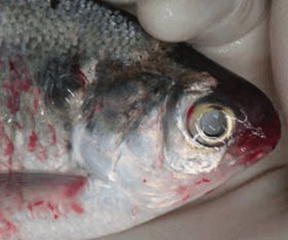Clinostomum marginatum
| Clinostomum marginatum | |
|---|---|
| | |
| Scientific classification | |
| Kingdom: | Animalia |
| Phylum: | Platyhelminthes |
| Class: | Trematoda |
| Order: | Strigeidida |
| Family: | Clinosomatidae |
| Genus: | Clinostomum |
| Species: | C. marginatum |
| Binomial name | |
| Clinostomum marginatum (Rudolphi, 1819) | |
Clinostomum marginatum is a species of parasitic fluke (class Trematoda). It is commonly called the "yellow grub". It is found in many freshwater fish in North America, and no fish, so far is immune to this parasite. This type of fluke can be found in the mouth of aquatic birds such as herons and egrets. They are also found commonly in the esophagus of fish-eating birds, and reptiles. Eggs of these trematodes are shed in the feces, hopefully into the water. Many aquatic birds become infected by ingesting freshwater fish that are infected. The metacercariae are found right beneath the skin or in the muscles.
Life cycle of this “yellow grub” consists of two intermediate hosts and one definitive host. The parasite’s eggs hatch in the water and the miracidium invades the foot of the snails. The cercaria leaves the snail and encysts in the muscle of the connective tissue of fresh-water species. The metacercarial stage is that is formed is then referred to as the “yellow grub”. The encysted metacercaria appears yellow, slightly oval spot, about 3 to 6 mm long. Metacercariae are common in the caudal, dorsal, and pectoral fins; on the inside surface of the operculum, and in the flesh. The adult trematode is found in the mouth and esophatus of herons and other fish-eating birds.
Morphology
C. maginatum is a yellow worm that can grow up to 6.4 millimetres (0.25 in) in the flesh of freshwater fish. Distinguishing characteristics of this parasite in the "miracidium" stage are three eyespots located on the mid-dorsal line, posterior of lateral papillae. These are cup-shaped and contains lens forming a triangle-shaped appearance on the parasite. They also contain two pairs of flame cells; one pair located on the anterior between the eyespots and lateral papillae and one pair on the posterior side. In addition, they have pairs of large refractive vacuoles, which are found near the flame cells. They differ in structure and physiological phenotypes depending on its habitat. However, ones found in herons were smooth, thick teguments and absorbed food such as glucose through facilitated diffusion.
Along with a thick tegument, these flukes were also found to have bacteria on them. The bacteria may play a role in the absorption and metabolism of glucose.
Life cycle
For its life cycle to be complete, Clinostomum marginatum requires two intermediate hosts (snail and fish) and one definitive host (bird). The life cycle begins when eggs hatch in the water. The miracidia swims and invades the foot of a snail of the genus Helisoma. They will die in several hours if they cannot find the snail host. While inside the snail, the miracidia undergo several asexual reproduction and the larvae eventually become cercariae. The cercariae form exits the snail and is free swimming in water, in search for a fitting fish host. They burrow inside the fish host, and the cercariae encyst and continue its next larval stage, known as "metacercariae", which are the yellow grubs. The grubs can live within the fish for several years until eaten by a bird host. When the parasitized fish is eaten, the grub matures in the throat of the bird. The eggs of the parasite known as a metacercariae are then released into the water through the bird's mouth when feeding and become adult flukes. This completes the life cycle.

Food source
These parasites may feed on the mucus of organs, food content ingested by the host, blood and tissue from eroding epithelial surfaces.
References
- The Parasite Clinostomum marginatum in Four Centrarchids, in California Ranch Pods. Author(s): Newman, Thomas F., Don A. Duncan, and Thomas K. Harp Source: Pacific Southwest Forest and Range Experiment Station. Forest Service U.S. Department of Agriculture, 1976 URL: http://www.fs.fed.us/psw/publications/documents/psw_rn314/psw_rn314.pdf
- Distribution of Clinostomum Marginatum (Yellow Grub) Metacercaria in Smallmouth Bass Populations from Crooked Creek in North Central Arkansas. Author(s): Daly,J., Hostetler T., Keller, R. 2002. URL: http://libinfo.uark.edu/aas/issues/2002v56/v56a6.pdf
- Studies on Clinostomum. II. The Miracidium of C. marginatum. Author(s): Hunter, W., Hunter,G. The Journal of Parasitology. Vol. 21, No.3 (June., 1935), pp 186-189 URL: http://www.jstor.org/stable/3271473?seq=3
- Yellow Grub Clinostomum (Trematoda). Department of Natural Resources and Environment. 2001-2010. URL: http://www.michigan.gov/dnr/0,1607,7-153-10364_52259_10950-26966--,00.html
- Fine Structure and Sugar Transport Functions of the Tegument in Clinostomum marginatum (Digenea: Clinostomatidae): Environmental Effects on the Adult Phenotype Author(s): Gary L. Uglem, Omer R. Larson, John M. Aho, Kook J. Lee Source: The Journal of Parasitology, Vol. 77, No. 5 (Oct., 1991), pp. 658-662 Published by: The American Society of Parasitologists Stable URL: http://www.jstor.org/stable/3282694
- http://www.wildlife.state.nh.us/Fishing/fisheries_management/grubby_fish.htm
- Bacteria Associated with the Tegument of Clinostomum marginatum (Digenea) John M. Aho, Gary L. Uglem, James P. Moore and Omer R. LarsonThe Journal of Parasitology Vol. 77, No. 5 (Oct., 1991), pp. 784-786 Published by: The American Society of Parasitologists http://www.jstor.org/stable/3282717
- http://libinfo.uark.edu/aas/issues/1999v53/v53a6.pdf
- http://www.fs.fed.us/psw/publications/documents/psw_rn314/psw_rn314.pdf
